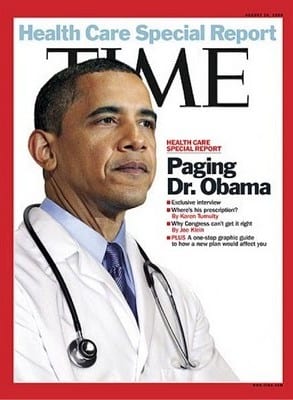Obamacare Fallout
by Stephen Lendman
Obama’s signature program is rife with inequities. It makes a dysfunctional system worse.
It rations healthcare. It’s unaffordable. It leaves millions uninsured. It leaves millions more underinsured. It compromises privacy. A little noticed disclaimer states:
“You have no reasonable expectation of privacy regarding any communication or data transmitting or stored on this information system.”
Medical privacy rights are violated. NSA and other US spy agencies will have full access to Americans’ medical history. They have lots more than that. More information below.
On October 24, Infowars headlined “CIA-Funded Software Company Manages Private Data for Healthcare.gov,” saying:
In-Q-Tel is a CIA venture capital firm. It’s “heavily invested into Socrata. (It’s a) software company (providing) data collection and management for Healthcare.gov and Medicare.gov.”
It announced a “strategic investment and technology development agreement with In-Q-Tel (IQT).”
Both “entities will work together to further develop Socrata’s data consumerization platform for internal business analysts in data-rich organizations.”
“Users of Socrata’s technologies can transform raw data from multiple sources into more sophisticated and useful resources.”
Socrata will work with NSA, CIA and other US spy agencies. They’ll do so to transform raw data into what’s more easily used.
Healthcare.gov obtained information includes place of residence, social security number, bank account numbers, other financial information, medical history, place of employment, earnings, immigration status, military background, criminal record if any, phone numbers and email addresses.
US spy agencies get it all. They can use it any way they wish. Obamacare is more than ripoff healthcare. It violates core constitutional rights. It exploits unprincipally. It does so secretly. It does more harm than good.
On October 24, Acting Man.com headlined “Obamacare Side Effect – Doctors Abandon the Health Care Insurance System Altogether,” saying:
Many apparently “had enough.” They’re opting out. They’re fed up with bureaucratic red tape. Obamacare makes it worse than ever. They’re going cash only.
They’re able to spend more time with patients. They don’t need extra staff help dealing with increasing amounts of paperwork.
Doing so requires treating more patients to cover costs. It results in less time spent on proper care.
Doug Nunamaker is a family physician. “The paperwork, the hassles, it just got (too) overwhelming,” he said. “We knew we had to find a better way to practice,” he added.
He charges flat monthly fees. It’s the equivalent of cheap insurance. For children, it’s $10. For adults up to age 44, it’s $50. Seniors pay $100.
He advises patients to carry high-deductible insurance coverage. It’s needed in case emergencies, serious illness or expensive treatments.
His patient list numbers 400 – 600. Before it was 2,500 – 4,000. He needed volume to cover expenses. He’s comfortable with more time for treatment.
“My professional life is better than expected,” he said. “My family life and personal time are better. This is everything I wanted out of family medicine.”
Small numbers of doctors operate this way. Others join them annually. American Academy of Family Physicians data show 4% did so in 2012. In 2010, it was 3%.
A 2013 Medscape survey found 6% of physicians practicing this way. Burdensome Obamacare mandates suggest increasing numbers opting out ahead.
They want less bureaucracy. They want more time for patients. They don’t want Washington or predatory insurers telling them how to practice. They want doctors and patients alone deciding.
At the same time, healthcare advocates raise concerns. Cash only medicine perhaps will end up excluding many less well off patients. Everyone should have equal access. Universal single-payer alone provides it.
Bureaucratic red tape is eliminated. Insurers don’t provide healthcare. Doctors do. Medicare’s original design worked as intended.
Enrolling was simple. It still is. Enormous savings are achieved. Universal coverage assures comprehensive affordable care.
Predatory middlemen are excluded. Doing so saves $400 billion or more annually. Using it for care instead of profits covers everyone.
Marketplace medicine prioritizes profits. It does so at the expense of equitable treatment. It lets private insurers game the system. It lets them rip off enrollees freely.
Commodified healthcare falls short. It has no place in free societies. Obamacare makes it less equitable than ever.
Powerful interests blocked earlier US healthcare reform efforts. In 1917, 15 states introduced health insurance coverage for all legislation.
Eight others established commissions to study doing so. Proposals were weak and confusing. They were dead on arrival.
In the 1930 and 1940s, government-sponsored health insurance resurfaced. The issue remained contentious. Industry giants again blocked change.
Post-war, employer-provided coverage increased. Retirees, the disabled, unemployed, and others were uninsured. Years of debate followed. Medicare and Medicaid resulted.
In 1965, amendments to Titles XVIII and XIX respectively of the 1935 Social Security Act established them. Efforts to cover everyone failed. Prospects today are far dimmer than then.
Obamacare eliminates the possibility. Healthcare giants writing the law designed it that way. On June 28, 2012, a Physicians for National Health Program press release said:
“What is truly unrealistic is believing that we can provide universal and affordable health care in a system dominated by private insurers and Big Pharma.”
“The American people desperately need a universal health system that delivers comprehensive, equitable, compassionate and high-quality care, with free choice of provider and no financial barriers to access.”
Convoluted arguments upheld ACA’s controversial individual mandate provision. Americans have no say. They’re required to buy coverage from private insurers. They have to whether or not they want it.
They’re cheated. They get much less than they pay for. Independent experts believe America’s least advantaged at left in no-man’s land.
Federal subsidies are woefully inadequate. They’ll get inadequate coverage at best. They’ll be denied expensive treatments if needed.
Imagine the world’s richest country mandating it. Everyone can get whatever they want based on the ability to pay. Inability means too bad, out of luck.
Ninety-year old Dr. Quentin Young is a longtime Physicians for National Health Program (PNHP) leading member. His newly released autobiograpy is titled “Everybody In, Nobody Out: Memoirs of a Rebel Without a Pause.”
“Had I been in Congress, I would have unequivocally voted against Obamacare,” he said. “It’s a bad bill.”
“We rather think because of its ability to enshrine and solidify the corporate domination of the health system, it’s worse than what we have now.”
Worse or better is immaterial, he stressed. “The health system isn’t working in this country – fiscally, medically, socially, morally.”
“I don’t have any sympathy for the idea that the president had to compromise because his opposition was strong.”
“Winning is not always winning the election. Winning is making a huge fight and then taking the fight to the people – re-electing people who are supporting your program and defeating those who aren’t.”
PNHP examined Obamacare mandate by mandate. It’s nightmarish in complexity. It’s fundamentally inequitable.
“To this day,” said Young, “much to the chagrin of many of our friends who wanted reform, I remain adamant in my rejection of Obamacare.”
Young and other single-payer advocates deplore private insurers. They game the system for profits. They deny or delay expensive treatments. They overcharge, underinsure, and exploit people unfairly.
Obama could have done things different, said Young. “He could have stuck to all the virtues of single payer.”
He acted polar opposite. He sold out the way he did to Wall Street. US consumers are stuck with what demands rejection.
Millions will learn how much to their chagrin. Young expects a dirty fight ahead to change things.
“I’m sure the battle over health care reform isn’t going away,” he said. Odds against winning today perhaps are greater than ever.
_______________________________________
ABOUT THE AUTHOR
Stephen Lendman lives in Chicago. He can be reached at lendmanstephen@sbcglobal.net.
His new book is titled “Banker Occupation: Waging Financial War on Humanity.”
http://www.claritypress.com/LendmanII.html
Visit his blog site at sjlendman.blogspot.com.
Listen to cutting-edge discussions with distinguished guests on the Progressive Radio News Hour on the Progressive Radio Network.
It airs Fridays at 10AM US Central time and Saturdays and Sundays at noon. All programs are archived for easy listening.
http://www.progressiveradionetwork.com/the-progressive-news-hour
___________________
APPENDIX
Consumers Abandoning Healthcare.gov
by Stephen Lendman
headlined “The Healthcare.gov Fiasco.”
“The contractors who made this website were at best sloppy, and at worst unqualified for the job,” it said.
“So why? How did this happen to arguably the most important and lasting website of this president’s administration?”
Systems in place had to “integrate into various legacy systems, and that system could only be tested so much, and that building a highly scalable FISMA (Federal Information Security Management Act) certified web service was impossible from the get-go.”
When things go wrong, they throw “more money at the same people who caused the problem to fix” it.
Consumers have until December 15 to be eligible for coverage on January 1. They initially had until February 15 to avoid being assessed penalties. Open enrollment at first ran through March 15.
On October 22, the Obama administration announced a six week extension before penalties are incurred. Consumers will have until March 31 to enroll. Those doing so by then won’t be penalized.
Fines thereafter will be assessed for not having coverage three straight months. Extra time is gotten to get it. Consumers needing it now have to muddle through best they can.
An October 26 Wall Street Journal op-ed calls Obamacare’s rollout a Titanic taking on water. It’s more than a huge embarrassment. It’s a major disaster. It’s a political one.
Despite about three and a half years to be ready, it crashed and burned. It’s Obama’s “brand.” It “informally carries his name.”
“It was unveiled with great fanfare.” It doesn’t work. It features “crashed systems, frozen screens, (and) phone registrations that prompt you back to the site that sent you to the 800 number.”
It’s a disaster with no solution so far. It’s unclear when or if things will be properly fixed.
Former Obama chief of staff Bill Daley was asked if Housing and Human Services (HHS) Secretary Kathleen Sebelius should be fired.
“To me that’s kind of like firing Captain Smith on the Titanic after it hit the iceberg,” he said.
October 1 was Obamacare rollout day. Everything should have gone smoothly. Problems should have been found and corrected in time. Consumers needing to enroll in healthcare exchanges can’t do so.
Consumer Reports advised its readers to avoid Healthcare.gov for another month. It’s “barely operational,” it said.
According to the Washington Post, traffic from October 1 to October 13 plummeted 88%.
On October 26, London’s Guardian headlined “Responsibility for Healthcare.gov’s IT problems lie with dot gov,” saying:
“This was a management not a technology failure. Obama’s error was not to empower technologists to tell him the truth.”
He bears full responsibility. It’s his signature program. It bears his name.
Merici Vinton was one of Consumer Financial Protection Board’s (CFPB) first digital lead employees. She assisted its chief technology official, Eugene Huang, in developing its technology and digital strategy.
She oversaw its successful ConsumerFinance.gov launch. She said making digital and tech work in government requires:
“(1) Never build a website that’s too big to fail; instead start small.
(2) Let’s do open source when possible (preferably always).
(3) Let’s have in house strategy, design, and tech.”
None of this is revolutionary, she said. It’s common private sector practice. “(M)any government agencies outsource their technical capabilities to the point where the vision and strategy is out of house.”
“Not only that, fixing a typo on a website can take 24 hours.” It shouldn’t be that way. “Start small, have a vision, fix federal hiring and procurement. And stop putting website requirements in legislation.”
CFPB does it right “and continues to,” she said. “We launched a pretty basic, consumer facing public website in six to eight weeks.”
Building a complaint intake system followed. It took six months. Mortgages, credit scores, bank accounts, and other products were added.
The system now integrates with over 100 financial institutions, government agencies and 50 states.
Everything wasn’t done at once. Rollouts proceeded incrementally. Knowledge gained along the way helped things go smoothly. The end product works as intended.
On October 25, Reuters headlined “Frustrated by Healthcare.gov. some consumers buy off exchange.”
They’re avoiding an inoperable web site. They’re contacting insurers directly. They’re enrolling on their own. Perhaps things should have been set up this way in the first place.
Some insurers report up to double the amount of normal traffic. If callers don’t qualify for government subsidies, they sign them up directly.
Off-exchange purchases may jeopardize the administration’s plan to enroll millions of Americans by March 31. January 1 eligibility requires doing so by December 15.
Many young healthy people may opt out altogether. A higher risk pool means higher costs.
On October 25, Reuters headlined “White House says ‘Obamacare’ website will be fixed by end of November.”
Administration official Jeffrey Zients heads efforts to fix things. He said Quality Software Services (QSSI) is overseeing repairs.
A year ago, lawmakers questioned it about earlier work. At issue is being owned by the nation’s largest health insurer, UnitedHealth Group.
QSSI helped helped set up Healthcare.gov. It’s the site’s second most important contractor after CGI. It worked on three areas:
- building a data hub to permit information transfers between different groups;
- designing a tool to help users register; and
- testing how technology it designed worked.
UnitedHealth Group’s ownership suggests a conflict of interest. Current web site problems indicate faulty QSSI design. Choosing it to oversee fixing its own flawed technology denotes poor selection.
Technology consultant Stanley Nachimson expressed surprise about QSSI’s involvement, saying:
“They certainly want to make sure the whole process is fixed and is operating correctly as quickly as possible. (S)ometimes it’s hard to review your own work.”
Will it fix what it botched in the first place? Is another firm more qualified to do it?
Until now, a technology company didn’t supervise the entire project. HHS’ Centers for Medicare and Medicaid Services (CMS) served as system integrator.
Problems will be fixed in weeks, claims Zients. It remains to be seen if his optimism matches reality.
QSSI’s executive vice president, Andrew Slavitt, said the administration waited until days before launch to fully test Healthcare.gov.
A simulation failed. The site crashed. Launch proceeded as planned. It proved disastrous. No one knows for sure when things will be resolved.
What wasn’t made right in three and half years may take months to do properly now. In the meantime, millions can’t sign up. Others haven’t done so. Perhaps many more aren’t sure what to do.
Washington runs web sites for 36 states. They’re troubled like Healthcare.gov. Another 14 states built their own exchanges. They have fewer problems to resolve.
QSSI’s parent company UnitedHealth spokesman Matt Stearns said:
“There are a number of other components to the registration system, all of which must work together seamlessly to ensure (glitch-free) registration.”
Since October 1, nearly 20 million attempts to access Healthcare.gov succeeded only about 500,000 times. A small subset of applicants actually got coverage.
The bottom line to date is a testimony to failure. It’s not the first time Washington botched things. On October 21, Computer World headlined “Healthcare.gov website ‘didn’t have a chance in hell.’
Most US IT projects fall short. They miss deadlines. They cost more than budgeted. They don’t satisfy users. “Such is the case with Healthcare.gov.”
According to research firm Standish Group, about 94% of federal technology projects in the last decade fell short. Over 41% failed completely.
The most likely failure is a “big bang” release like Healthcare.gov. Other problems involve too many changes along the way and too much bureaucracy fouling up things.
Large projects require slow, incremental rollouts. Testing and feedback are needed. Glitches found need fixing before introducing more parts of the whole package.
Cast software analysis and measurement firm senior vice president Lev Lesokhin said Healthcare.gov isn’t just a web site. It has lots of moving parts.
It has many interactions and interdependencies with other government agencies and private sector firms. It has hundreds of thousands of lines of code. It’s a very complex design.
It won’t be easy fixing what’s wrong. It remains to be seen if doing it in weeks is possible. Poor design may require enormous amounts of time, effort and cost to fix.
In the meantime, uninsured Americans needing coverage can’t easily get it. Poor ones qualifying for subsidies may end up waiting longest.
Obama bears full responsibility. It’s his signature program. It bears his name. Its failure reflects another stain on his legacy.
It’s fitting for a program that never should have been introduced in the first place. Its worst problems are yet to come. They’re unrelated to web site glitches.
___________________________________
.
His new book is titled “Banker Occupation: Waging Financial War on Humanity.”
http://www.claritypress.com/LendmanII.html
Visit his blog site at sjlendman.blogspot.com.
Listen to cutting-edge discussions with distinguished guests on the Progressive Radio News Hour on the Progressive Radio Network.
It airs Fridays at 10AM US Central time and Saturdays and Sundays at noon. All programs are archived for easy listening.
http://www.progressiveradionetwork.com/the-progressive-news-hour
http://www.dailycensored.com/consumers-abandon-healthcare-gov/




 No sex in the city: (from left) friends Emi Kuwahata, 23, and Eri Asada, 22, shopping in Tokyo. Photograph: Eric Rechsteiner/Panos Pictures
No sex in the city: (from left) friends Emi Kuwahata, 23, and Eri Asada, 22, shopping in Tokyo. Photograph: Eric Rechsteiner/Panos Pictures ‘I often get asked out by married men in the office who want an affair as I am single. But I can’t be bothered’: Eri Tomita, 32. Photograph: Eric Rechsteiner/Panos PicturesThe sense of crushing obligation affects men just as much. Satoru Kishino, 31, belongs to a large tribe of men under 40 who are engaging in a kind of passive rebellion against traditional Japanese masculinity. Amid the recession and unsteady wages, men like Kishino feel that the pressure on them to be breadwinning economic warriors for a wife and family is unrealistic. They are rejecting the pursuit of both career and romantic success.
‘I often get asked out by married men in the office who want an affair as I am single. But I can’t be bothered’: Eri Tomita, 32. Photograph: Eric Rechsteiner/Panos PicturesThe sense of crushing obligation affects men just as much. Satoru Kishino, 31, belongs to a large tribe of men under 40 who are engaging in a kind of passive rebellion against traditional Japanese masculinity. Amid the recession and unsteady wages, men like Kishino feel that the pressure on them to be breadwinning economic warriors for a wife and family is unrealistic. They are rejecting the pursuit of both career and romantic success. ‘I find women attractive but I’ve learned to live without sex. Emotional entanglements are too complicated’: Satoru Kishino, 31. Photograph: Eric Rechsteiner/Panos PicturesKishino, who works at a fashion accessories company as a designer and manager, doesn’t knit. But he does like cooking and cycling, and platonic friendships. “I find some of my female friends attractive but I’ve learned to live without sex. Emotional entanglements are too complicated,” he says. “I can’t be bothered.”
‘I find women attractive but I’ve learned to live without sex. Emotional entanglements are too complicated’: Satoru Kishino, 31. Photograph: Eric Rechsteiner/Panos PicturesKishino, who works at a fashion accessories company as a designer and manager, doesn’t knit. But he does like cooking and cycling, and platonic friendships. “I find some of my female friends attractive but I’ve learned to live without sex. Emotional entanglements are too complicated,” he says. “I can’t be bothered.”

